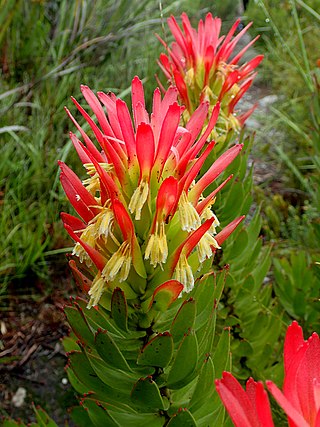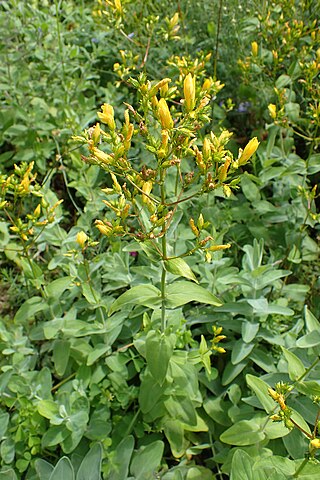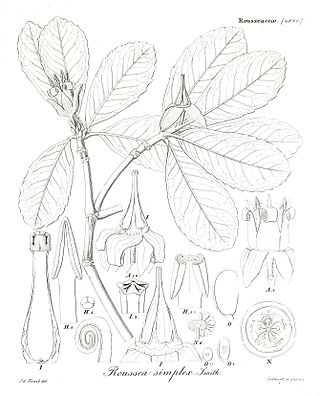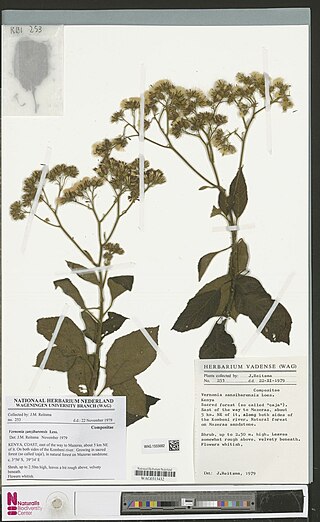
Babiana is a genus of geophytes in the family Iridaceae with 93 recognized species as of March 2022. The leaves consist of a stalk and a blade that are at an angle to each other. The leaf blades are entire, laterally flattened and pleated, and often hairy. Each individual flower is subtended by two hairy or smooth bracts that are green in most species. The outer bract is often the largest of the two. In most species the bracts have a dry, brown tip, but in a few species it is entirely green or entirely dry when flowering or the outer bract is translucent and has a papery texture. The inner bract is forked or split all the way to its base. Each flower is without a pedicel, with six tepals that are merged at their base into a tube and form a perianth that is mirror-symmetrical in most species, with three anthers implanted where the perianth tube widens and that are, in almost every species, clustered at one side of the style. The style has three branches that widen towards the tip and the ovary is inferior. Flowers occur in almost every conceivable colour, many have markings on some of the tepals, and few star-symmetrical flowers have a centre that strongly contrasts with the free part of the perianth. The majority of these species are endemic to the west and southwest of South Africa, and southwestern Namibia, but one species occurs elsewhere in Namibia and South Africa and another species can be found in Botswana, Namibia, South Africa, Zambia and Zimbabwe. The genus name is derived from the Dutch word baviaan, referring to the Chacma baboon, Papio ursinus, that consumes the corms of plants in the genus. The genus is called bobbejaantjie in Afrikaans, meaning small baboon.

Vachellia cornigera, commonly known as bullhorn acacia, is a swollen-thorn tree and Myrmecophyte native to Mexico and Central America. The common name of "bullhorn" refers to the enlarged, hollowed-out, swollen thorns that occur in pairs at the base of leaves, and resemble the horns of a steer. In Yucatán it is called "subín", in Panamá the locals call them "cachito". The trees are commonly found in wet lowlands

Nectar is a sugar-rich liquid produced by plants in glands called nectaries or nectarines, either within the flowers with which it attracts pollinating animals, or by extrafloral nectaries, which provide a nutrient source to animal mutualists, which in turn provide herbivore protection. Common nectar-consuming pollinators include mosquitoes, hoverflies, wasps, bees, butterflies and moths, hummingbirds, honeyeaters and bats. Nectar plays a crucial role in the foraging economics and evolution of nectar-eating species; for example, nectar foraging behavior is largely responsible for the divergent evolution of the African honey bee, A. m. scutellata and the western honey bee.

Vachellia collinsii, previously Acacia collinsii, is a species of flowering plant native to Central America and parts of Africa.
This page provides a glossary of plant morphology. Botanists and other biologists who study plant morphology use a number of different terms to classify and identify plant organs and parts that can be observed using no more than a handheld magnifying lens. This page provides help in understanding the numerous other pages describing plants by their various taxa. The accompanying page—Plant morphology—provides an overview of the science of the external form of plants. There is also an alphabetical list: Glossary of botanical terms. In contrast, this page deals with botanical terms in a systematic manner, with some illustrations, and organized by plant anatomy and function in plant physiology.

Mimetes cucullatus is an evergreen shrub with several, mostly not branching, upright stems of 1–2 m (3–7 ft) high, that has been assigned to the family Proteaceae. It is the most widespread and most common pagoda species that can cope with a relatively large range of environmental circumstances. It is known under several names including common pagoda in English and rooistompie in Afrikaans.

Chamaecrista fasciculata, the partridge pea, is a species of legume native to most of the eastern United States. It is an annual which grows to approximately 0.5 meters tall. It has bright yellow flowers from early summer until first frost, with flowers through the entire flowering season if rainfall is sufficient.

Senna italica, the Port Royal senna, Italian senna, or Senegal senna is a legume tree in the genus Senna. It is recognized by many other common names based on the regions it grows in. In India, it is used to produce a powder for treating hair-related diseases which is known as “neutral henna”. Whereas, in some parts of the world, this species is cultivated for the leaves which yield the drug senna, known commonly as Senna glycoside, which in turn is the base for a laxative. Senegal senna is easily distinguishable through its many distinctive features. There are 3 subspecies of this plant based on the size of the inflorescence and the length of the petiole. The subspecies are italica, micrantha, and arachoides. In many regions, this plant is cultivated commercially and medicinally.

Turnera subulata is a species of flowering plant in the passionflower family known by the common names white buttercup, sulphur alder, politician's flower, dark-eyed turnera, and white alder. Despite its names, it is not related to the buttercups or the alders. It is native to Central and South America, from Panama south to Brazil. It is well known in many other places as an introduced species, such as Malaysia, Indonesia, several other Pacific Islands, the Caribbean, and Florida in the United States.

Hypericum annulatum is a species of flowering plant in the family Hypericaceae. It is a perennial herb of varying heights which grows upright, with more than a hundred flowers of a golden yellow color. First described in 1827, the species has a wide distribution from Eastern Europe to East Africa, and its appearance can vary greatly based on its geographic location. It has been used in Bulgarian folk medicine, and has more recently been investigated for its effectiveness in slowing the growth of or killing certain types of human cancer.

Roussea simplex is a woody climber of 4–6 m high, that is endemic to the mountain forest of Mauritius. It is the only species of the genus Roussea, which is assigned to the family Rousseaceae. It has opposing, entire, obovate, green leaves, with modest teeth towards the tip and mostly pentamerous, drooping flowers with yellowish recurved tepals, and a purse-shaped orange corolla with strongly recurved narrowly triangular lobes.

Polanisia erosa is a sticky, 10–60 cm (3.9–23.6 in) high annual herbaceous species of flowering plant in the Cleome family, Cleomaceae, known by the common name large clammyweed. It has narrow clover-like leaves, and cream-coloured, frilly flowers with a yellowish centre, looking a bit like a small butterfly or a set of elk antlers. It naturally occurs in dry and sandy habitats in Texas and adjacent parts of Arkansas, Louisiana and Oklahoma.

Mimetes argenteus is an evergreen, upright, hardly branching, large shrub of about 2 m (6½ ft) high in the family Proteaceae. It has elliptic, silvery leaves, due to a dense covering of silky hairs, that stand out a right angle from the branches. It has cylindric inflorescences of 8–15 cm (3–6 in) long and 10–12 cm (4–5 in) in diameter, crested by smaller silvery pink leaves at an upright angle. These consist of many flower heads, each containing six to nine individual flowers and ar set in the axil of a leaf flushed mauve to carmine. It flowers from March to June. The silver pagoda naturally occurs in the Western Cape province of South Africa. It is called silver pagoda or silver-leaved bottlebrush in English and vaalstompie in Afrikaans.

Felicia dregei is an evergreen, glandular shrub of up to 11⁄2 m (5 ft) high, that is assigned to the family Asteraceae. It has flat, finely felty, grayish green, narrowly elliptic to lance-shaped leaves of up to 4 cm long and 8 mm wide, with an entire margin or here and there with up to ten teeth. The flower heads have about ten violet ray florets, encircling many yellow disc florets. This species grows in the Northern Cape and Western Cape provinces of South Africa.

Crassula subaphylla is a succulent plant belonging to the family Crassulaceae. It is widespread in the Karoo regions of South Africa and Namibia.

Codonanthopsis is a genus of flowering plants in the family Gesneriaceae. Its native range is from southern Mexico through tropical America to Bolivia and most of Brazil. Codonanthopsis species are generally trailing epiphytes with pale flowers. Most have a mutualistic relationship with tree-living ants: the plants provide the ants with food, including nectar, and give their nests structure and support, while the ants disperse the plants' seeds. The genus was considerably expanded in 2013 when species were transferred from Codonanthe. Some Codonanthopsis species are cultivated as houseplants, when they may be grown in hanging baskets.

Jeffreycia is a genus of African flowering plants in the family Asteraceae. They are in the tribe Vernonieae.

Babiana vanzijliae is a species of geophyte of 4–12 cm (1.6–4.7 in) high that is assigned to the family Iridaceae. It has leaves that consist of a sheath and a blade that are at an angle with each other. The leaf blades are narrow, sword- to lance-shaped and have a left and right surface, rather than an upper and lower surface. The leaf blades are pleated and covered in velvety hairs. The inflorescence contains three to five pale bluish mauve to yellow flowers, but the lower lateral tepals are yellow becoming pale around the edges, and with three stamens crowding under the upper lip. Flowering occurs from early August to the middle of September. The flowers emit a strong scent. B. vanzijliae grows along the Bokkeveld Escarpment near Nieuwoudtville in the Northern Cape province of South Africa.

Passiflora glandulosa, more commonly known as wild passion fruit, is a short deciduous climbing plant with stems that can grow up to 20 m (66 ft) long. The genus Passiflora is known for its colorful flowers, which is also prominent in the glandulosa species. Named by Antonio José Cavanilles in 1790, Passiflora glandulosa is native to many regions of the northeast coast of South America, having a neotropic distribution. In specific, Passiflora glandulosa is heavily populated in Guyana, Suriname, Brazil and French Guiana.

Chlorocyathus lobulata is a species of plant in the Apocynaceae family. It is native to the Cape Provinces of South Africa. Hendrik J. T. Venter and Rudolf L. Verhoeven, the botanists who first formally described the species named it, using the synonym Raphionacme lobulata, after the distinctive lobes of the corona of its flowers.



















